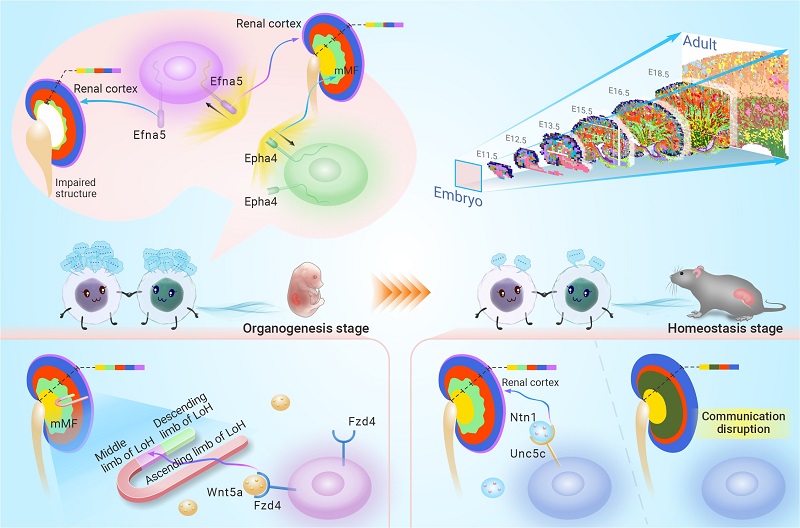Scientists Unveil Mechanisms Underlying Kidney Structure Development and Homeostasis Maintenance
As a vital metabolic organ in mammals, abnormalities in kidney structure are often closely linked to congenital malformations and chronic kidney diseases. Data shows that the incidence of congenital kidney developmental abnormalities in neonates is as high as 1.6‰. However, there is currently no comprehensive or systematic understanding of the kidney's structural formation process and its underlying molecular mechanism.
On January 17, 2025, a joint study conducted by Dr. LIU, Jiang's group from the Institute of Biophysics of the Chinese Academy of Sciences and Dr. KE, Yuwen's group from the China Agricultural University, utilizing a single-cell spatial transcriptomic atlas of mouse kidneys during development, revealed the regulatory role of cell communication in the establishment and maintenance of kidney structure.
By employing spatial transcriptomics at single-cell resolution, the researchers constructed a spatial and temporal transcriptomic atlas of mouse kidney development, exploring the molecular mechanisms underlying the establishment of kidney structure and the maintenance of homeostasis.
The researchers found that during kidney development, there are numerous cell-cell communication events related to migration, and identified a five-layer structural formation in the fetal kidney, overturning the traditional two-layer model, revealing the spatial distribution of cell types and gene expression patterns at different layers.
Notably, the researchers discovered that Ephrin-A5 is crucial for the formation of three distinct layers in the kidney medulla, while the Frizzled 4 receptor is key for the development of the U-shaped loop of Henle.
Additionally, this study highlighted the differences between migration-related cell communication during kidney development and the structural homeostasis in adulthood, suggesting that reactivating these cell communications could become a new strategy for kidney regeneration.
This study generated the first single-cell resolution spatial and temporal transcriptomic atlas of the mouse kidney, revealing the central role of cell-to-cell communication in organ development and the maintenance of adult homeostasis, providing important theoretical foundation for future organ regeneration research.

Figure. The Regulatory Roles of Cell Communication in Kidney Structure Development and Homeostasis Maintenance
(Image by LIU Jiang's group)
Article link: https://doi.org/10.1016/j.xinn.2024.100767
Contact: LIU Jiang
Institute of Biophysics, Chinese Academy of Sciences
Beijing 100101, China
E-mail: liujiang@ibp.ac.cn
(Reported by Prof. LIU Jiang's group)

